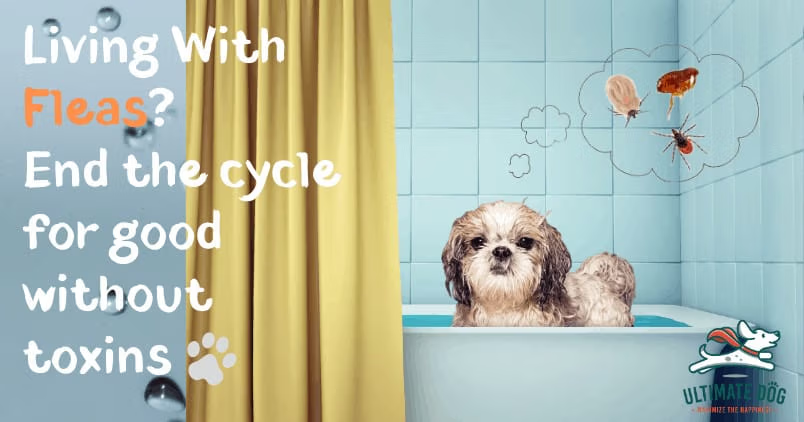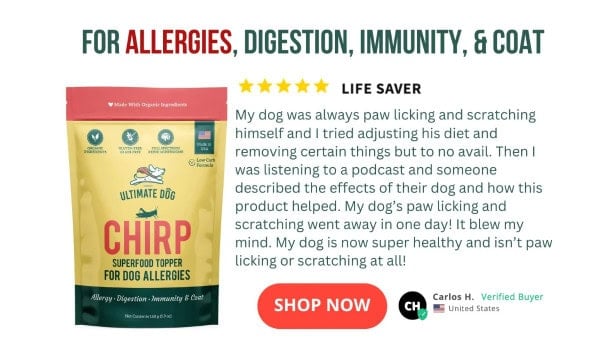Realizing your dog has fleas can be unnerving. Especially if your dog happens to be one of your favorite cuddle buddies. The thought of fleas bedding down with you at night is enough to drive most owners straight to the pet supply store in search of some pesticide-laden products that are guaranteed to kill those fleas dead.
But before you jump to those extremes, know that there are natural options that can be just as effective as the chemical ones but without the nasty side effects. And best of all, you probably already have many of these items in your home right now.
The Dark Side of Commercial Flea Products
Before we get into the natural alternatives for battling a flea infestation, let’s look at why commercial flea products are worth avoiding.
The most common flea and tick treatments on the market are topical gels that are applied to your dog’s coat. These products are meant to be placed between your pet’s shoulder blades so they can’t lick them off. In fact, they are so noxious that they require you to wear gloves during application and they are not recommended to be handled by children.
These products quickly mix with your dog’s natural coat oils and spread across their skin to cover their entire body. While this is the only way they can be effective in killing all the fleas living on your dog, it also means that you and your children can’t avoid getting these products on your skin. Unless, of course, you stop petting your dog entirely. But who wants to do that?
While oral commercial treatments may pose less of a risk to you as an owner, both types can still cause a lot of nasty side effects for your dog. These include gastrointestinal upset, itching and irritated skin, and even severe neurological issues like ataxia and seizure. In severe cases, dogs have even died as a result of oral and topical flea treatments.
Both the EPA and FDA have released reports warning consumers to be aware of the dangers associated with these products. These dangers seem to be especially high for smaller dogs who appear to need much smaller doses than what is currently listed on many brands’ packaging. Cats are also at increased risk as they cannot tolerate certain chemicals used in dog only treatments but can easily come in contact with them if a dog in the house has been treated.
Natural Dog Flea Treatments That Work
As bad as having a flea-infested pooch is, exposing your best friend to pesticides that can cause neurological damage or even death, is much worse. Luckily, there are some inexpensive, natural dog flea treatments that can have your pup running flea free without the worry.
A Good Old Fashioned Bath
In addition to topical and oral medication, you are likely to find a number of “flea shampoos” for sale at your local pet store. Not surprisingly, these often contain chemical additives meant to kill fleas on contact. What is surprising, is that these chemicals are completely unnecessary.
For centuries, horticulturalists have used soapy water to kill pests that attack their plants. While natural detergents are completely harmless to animals and plants, they are deadly to most insects. That’s because soap washes away the waxy outer layer that protects bugs from outside elements. Once that protection is gone, the insect, who breathes through its skin, will quickly drown in the residual water or dry out as its own moisture leaves its body.
This same process happens to fleas when they are exposed to soap. And you don’t need any special kind of shampoo to achieve this effect, either. Simple, natural dog shampoos will work just fine.
Of course, in order to kill all the adult fleas, and the eggs and larvae living on your dog, you must expose them all to the soap. You will want to fully lather and rinse your dog twice to help wash away their own protective skin oil first to allow the soap to penetrate deep into the coat. Leaving the shampoo on for a few minutes and massaging your fingers into your dog’s armpits, folds, and areas with thick hair will also help.
Unlike medicated shampoos that leave chemicals behind, normal soap will only kill fleas during the course of the bath. So washing your dog every few days is a good way to ensure you don’t miss any pests.
Once your dog appears to be flea free, you should stop bathing them as frequently to avoid overdrying their skin. But keep an eye out for repeat infestations and consider some of the following natural treatments to repel fleas in the future.
Homemade Flea Repellent Sprays
After you have bathed your dog and eradicated the fleas and their eggs with soap, it is a good idea to spritz your dog with a natural flea repellant. Not only do these homemade sprays keep new fleas from jumping onto your dog, but they can also kill any remaining survivors who didn’t succumb to the soap.
The simplest natural flea spray can be made by mixing two parts water with three parts apple cider vinegar. The acidic vinegar naturally deters pests of all types, including fleas, ticks, and mosquitos. And fleas who have had their defenses weakened by the recent shampooing can quickly become overwhelmed by the substance.
To up the repelling power of your spritz, try adding some essential oils. Peppermint, lemon, eucalyptus, lavender, and neem oils are all safe for dogs when diluted while fleas and ticks will find these oils overpowering.
Coconut Oil Salve
Another great natural flea treatment to give your pup after their bath is a coconut oil rubdown. Fleas are especially sensitive to the lauric acid found in this oil and it can kill them on contact. Additionally, just as mayonnaise can effectively kill head lice by suffocating it, coconut oil can suffocate adult fleas.
Even better, coconut oil is soothing to the skin and is a great way to reduce the redness and itching many dogs with fleas experience. Make sure to rub the oil on your dog’s belly, the inside of their legs, and any other areas that seem especially inflamed.
Treat From Inside
Once you have your dog flea-free, you’ll want to keep them that way. Continuing to use your homemade flea repellant spray throughout the flea season is a good idea, but if you want to do more, consider a natural oral supplement.
B-vitamins have long been used to ward off mosquitoes and many owners have found success using them for fleas as well. Most of the natural flea supplements you’ll find on the market include multiple B-vitamins for this reason.
Garlic can also be an effective flea defense. Some owners do shy away from garlic use in dogs because alliums like garlic and onions are thought to cause anemia in pets. While many holistic vets recommend garlic in low doses and plenty of commercial pet supplements contain garlic, it’s always best to proceed with caution and do what feels most comfortable to you.
Don’t Forget to Treat Your Home
While ridding your dog of fleas with these natural treatments is relatively easy, getting these creepy bugs out of your house can take a bit more work. But it is an important step to avoid repeat exposure.
Fleas need to feed off a host to survive, but they can live on furniture and bedding for up to a week. Larval fleas that have entered the cocoon phase can enter a dormant state and survive without eating for almost half a year!
If your dog has fleas and has been inside your house, you can pretty much guarantee that at least a few of those little bloodsuckers have jumped ship. As you are going through the process of de-fleaing your dog, it is important to take similar steps with any areas of your home that they have been in contact with.
Wash bedding with hot water and plenty of detergent. Sprinkle baking soda over carpets and in the cracks of furniture to dry out any fleas that may be hiding there. After a day, vacuum the areas thoroughly to remove any dead or dying fleas. Make sure to empty your vacuum right away just in case you do happen across any live stowaways.
Depending on where you live, fleas may be a rare occurrence or a constant problem. If your dog has had fleas more than once, your yard may be the culprit. Luckily, there are natural ways to reduce their population, including nematode sprays and diatomaceous earth. Using these treatments in conjunction with preventative measures used directly on your dog is the best way to avoid future problems.
In the end, it may take a little extra work to address fleas the natural way. But doing so will guarantee you keep your dog and family safe from the dangers of chemical flea treatments.
Sources
“Animal Drug Safety Communication: FDA Alerts Pet Owners and Veterinarians About Potential for Neurologic Adverse Events Associated with Certain Flea and Tick Products.” FDA.gov, 8 Aug 2019.
“EPA Evaluation of Pet Spot-on Products: Analysis and Plans for Reducing Harmful Effects.” EPA.gov.
Natasha Kassell, VDM. “Treating and Preventing Fleas.” holisticvetphilly.com, 30 March 2014.

Sara Seitz worked in the pet industry for over a decade. In addition to being a certified dog trainer, Sara gained experience working as the general manager of a dog daycare and boarding facility, as the creator and manager of a pet sitting company, as a groomer, and as a dog behavior evaluator. She also has a bachelors in animal behavior from CSU. Currently, Sara works as a freelance writer specializing in blog, article and content writing.




Leave a Comment